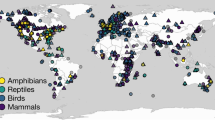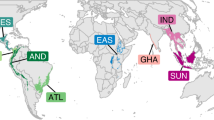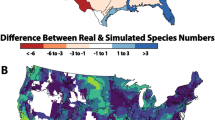Abstract
The United Nations recently agreed to major expansions of global protected areas (PAs) to slow biodiversity declines1. However, although reserves often reduce habitat loss, their efficacy at preserving animal diversity and their influence on biodiversity in surrounding unprotected areas remain unclear2,3,4,5. Unregulated hunting can empty PAs of large animals6, illegal tree felling can degrade habitat quality7, and parks can simply displace disturbances such as logging and hunting to unprotected areas of the landscape8 (a phenomenon called leakage). Alternatively, well-functioning PAs could enhance animal diversity within reserves as well as in nearby unprotected sites9 (an effect called spillover). Here we test whether PAs across mega-diverse Southeast Asia contribute to vertebrate conservation inside and outside their boundaries. Reserves increased all facets of bird diversity. Large reserves were also associated with substantially enhanced mammal diversity in the adjacent unprotected landscape. Rather than PAs generating leakage that deteriorated ecological conditions elsewhere, our results are consistent with PAs inducing spillover that benefits biodiversity in surrounding areas. These findings support the United Nations goal of achieving 30% PA coverage by 2030 by demonstrating that PAs are associated with higher vertebrate diversity both inside their boundaries and in the broader landscape.
This is a preview of subscription content, access via your institution
Access options
Access Nature and 54 other Nature Portfolio journals
Get Nature+, our best-value online-access subscription
$29.99 / 30 days
cancel any time
Subscribe to this journal
Receive 51 print issues and online access
$199.00 per year
only $3.90 per issue
Buy this article
- Purchase on Springer Link
- Instant access to full article PDF
Prices may be subject to local taxes which are calculated during checkout





Similar content being viewed by others
Data availability
Data used in the mixed-effects modelling analysis are available at https://doi.org/10.6084/m9.figshare.22527298.v1. Rasters (1-km resolution) for the study area for the GEDI-derived forest structural covariates and estimated site accessibility are available at https://rcdata.nau.edu/geode_data/SEA_vertebrate_diversity_rasters/.
Code availability
Codes for analysis (in the R programming language) are available at https://doi.org/10.5281/zenodo.7796347.
Change history
09 April 2024
A Correction to this paper has been published: https://doi.org/10.1038/s41586-024-07333-z
05 January 2024
A Correction to this paper has been published: https://doi.org/10.1038/s41586-023-07007-2
References
UN. Kunming Declaration. Declaration from the High-Level Segment of the UN Biodiversity Conference 2020 (Part 1) Under the Theme: “Ecological Civilization: Building a Shared Future for All Life on Earth” (Final Draft) (United Nations Biodiversity Conference, 2021).
Chen, C. et al. Global camera trap synthesis highlights the importance of protected areas in maintaining mammal diversity. Conserv. Lett. 15, e12865 (2022).
Geldmann, J., Manica, A., Burgess, N. D., Coad, L. & Balmford, A. A global-level assessment of the effectiveness of protected areas at resisting anthropogenic pressures. Proc. Natl Acad. Sci. USA 116, 23209–23215 (2019).
Pollock, L. J. et al. Protecting biodiversity (in all its complexity): new models and methods. Trends Ecol. Evol. 35, 1119–1128 (2020).
Wauchope, H. S. et al. Protected areas have a mixed impact on waterbirds, but management helps. Nature 605, 103–107 (2022).
Benítez-López, A. et al. The impact of hunting on tropical mammal and bird populations. Science 356, 180–183 (2017).
Laurance, W. F. et al. Averting biodiversity collapse in tropical forest protected areas. Nature 489, 290–294 (2012).
Bode, M., Tulloch, A. I., Mills, M., Venter, O. & Ando, A. W. A conservation planning approach to mitigate the impacts of leakage from protected area networks. Conserv. Biol. 29, 765–774 (2015).
Kriegel, M., Elias Ilosvay, X. E., von Dorrien, C. & Oesterwind, D. Marine protected areas: at the crossroads of nature conservation and fisheries management. Front. Mar. Sci. 8, 676264 (2021).
Leverington, F., Costa, K. L., Pavese, H., Lisle, A. & Hockings, M. A global analysis of protected area management effectiveness. Environ. Manage. 46, 685–698 (2010).
Nolte, C., Agrawal, A., Silvius, K. M. & Soares-Filho, B. S. Governance regime and location influence avoided deforestation success of protected areas in the Brazilian Amazon. Proc. Natl Acad. Sci. USA 110, 4956–4961 (2013).
Geldmann, J. et al. Changes in protected area management effectiveness over time: a global analysis. Biol. Conserv. 191, 692–699 (2015).
Andam, K. S., Ferraro, P. J., Pfaff, A., Sanchez-Azofeifa, G. A. & Robalino, J. A. Measuring the effectiveness of protected area networks in reducing deforestation. Proc. Natl Acad. Sci. USA 105, 16089–16094 (2008).
Graham, V. et al. Southeast Asian protected areas are effective in conserving forest cover and forest carbon stocks compared to unprotected areas. Sci. Rep. 11, 23760 (2021).
Ferraro, P. J. & Hanauer, M. M. Quantifying causal mechanisms to determine how protected areas affect poverty through changes in ecosystem services and infrastructure. Proc. Natl Acad. Sci. USA 111, 4332–4337 (2014).
Gray, C. L. et al. Local biodiversity is higher inside than outside terrestrial protected areas worldwide. Nat. Commun. 7, 12306 (2016).
Jung, M. et al. The global exposure of species ranges and protected areas to forest management. Divers. Distrib. 28, 1487–1496 (2022).
Coetzee, B. W., Gaston, K. J. & Chown, S. L. Local scale comparisons of biodiversity as a test for global protected area ecological performance: a meta-analysis. PLoS ONE 9, e105824 (2014).
Geldmann, J. et al. Effectiveness of terrestrial protected areas in reducing habitat loss and population declines. Biol. Conserv. 161, 230–238 (2013).
Joppa, L. N. & Pfaff, A. High and far: biases in the location of protected areas. PLoS ONE 4, e8273 (2009).
McCarthy, D. P. et al. Financial costs of meeting global biodiversity conservation targets: current spending and unmet needs. Science 338, 946–949 (2012).
Naidoo, R. & Iwamura, T. Global-scale mapping of economic benefits from agricultural lands: implications for conservation priorities. Biol. Conserv. 140, 40–49 (2007).
Arif, S. & MacNeil, M. A. Predictive models aren’t for causal inference. Ecol. Lett. 25, 1741–1745 (2022).
Pearl, J. & Mackenzie, D. The Book of Why: The New Science of Cause and Effect (Basic Books, 2018).
Schleicher, J. et al. Statistical matching for conservation science. Conserv. Biol. 34, 538–549 (2020).
Hansen, M. C. et al. High-resolution global maps of 21st-century forest cover change. Science 342, 850–853 (2013).
Tilker, A. et al. Habitat degradation and indiscriminate hunting differentially impact faunal communities in the Southeast Asian tropical biodiversity hotspot. Commun. Biol. 2, 396 (2019).
Valbuena, R. et al. Standardizing ecosystem morphological traits from 3D information sources. Trends Ecol. Evol. 35, 656–667 (2020).
Pillay, R. et al. Humid tropical vertebrates are at lower risk of extinction and population decline in forests with higher structural integrity. Nat. Ecol. Evol. 6, 1840–1849 (2022).
Hansen, A. J. et al. A policy-driven framework for conserving the best of Earth’s remaining moist tropical forests. Nat. Ecol. Evol. 4, 1377–1384 (2020).
Navarro, L. M. et al. Monitoring biodiversity change through effective global coordination. Curr. Opin. Environ. Sustain. 29, 158–169 (2017).
Walpole, M. et al. Tracking progress toward the 2010 biodiversity target and beyond. Science 325, 1503–1504 (2009).
Marselis, S. M. et al. Evaluating the potential of full-waveform lidar for mapping pan-tropical tree species richness. Global Ecol. Biogeogr. 29, 1799–1816 (2020).
Dubayah, R. et al. The Global Ecosystem Dynamics Investigation: high-resolution laser ranging of the Earth’s forests and topography. Sci. Remote Sens. 1, 100002 (2020).
Deith, M. C. & Brodie, J. F. Predicting defaunation: accurately mapping bushmeat hunting pressure over large areas. Proc. R. Soc. B 287, 20192677 (2020).
Brodie, J. F. & Fragoso, J. M. Understanding the distribution of bushmeat hunting effort across landscapes by testing hypotheses about human foraging. Conserv. Biol. 35, 1009–1018 (2021).
Venter, O. et al. Sixteen years of change in the global terrestrial human footprint and implications for biodiversity conservation. Nat. Commun. 7, 1272 (2016).
Kleinschroth, F., Laporte, N., Laurance, W. F., Goetz, S. J. & Ghazoul, J. Road expansion and persistence in forests of the Congo Basin. Nat. Sustain. 2, 628–634 (2019).
Benítez-López, A., Santini, L., Schipper, A. M., Busana, M. & Huijbregts, M. A. Intact but empty forests? Patterns of hunting-induced mammal defaunation in the tropics. PLoS Biol. 17, e3000247 (2019).
Bogoni, J. A., Percequillo, A. R., Ferraz, K. M. & Peres, C. A. The empty forest three decades later: lessons and prospects. BioTropica 55, 13–18 (2023).
Stouffer, P. C. et al. Long‐term change in the avifauna of undisturbed Amazonian rainforest: ground‐foraging birds disappear and the baseline shifts. Ecol. Lett. 24, 186–195 (2021).
Brodie, J. F. & Gibbs, H. K. Bushmeat hunting as climate threat. Science 326, 364–365 (2009).
Di Lorenzo, M., Claudet, J. & Guidetti, P. Spillover from marine protected areas to adjacent fisheries has an ecological and a fishery component. J. Nat. Conserv. 32, 62–66 (2016).
Chen, C. et al. Effects of law enforcement and community outreach on mammal diversity in a biodiversity hotspot. Conserv. Biol. 33, 612–622 (2019).
Oliveira, P. J. et al. Land-use allocation protects the Peruvian Amazon. Science 317, 1233–1236 (2007).
Brodie, J. F., Williams, S. & Garner, B. The decline of mammal functional and evolutionary diversity worldwide. Proc. Natl Acad. Sci. USA 118, e1921849118 (2021).
Brodie, J. F. Synergistic effects of climate change and agricultural land use on mammals. Front. Ecol. Environ. 14, 20–26 (2016).
Legras, G., Loiseau, N. & Gaertner, J.-C. Functional richness: overview of indices and underlying concepts. Acta Oecologica 87, 34–44 (2018).
Brodie, J. F., Redford, K. H. & Doak, D. F. Ecological function analysis: incorporating species roles into conservation. Trends Ecol. Evol. 33, 840–850 (2018).
Faith, D. P. Conservation evaluation and phylogenetic diversity. Biol. Conserv. https://doi.org/10.1016/0006-3207(92)91201-3 (1992).
Fink, D. et al. A double machine learning trend model for citizen science data. Preprint at https://doi.org/10.48550/arXiv.2210.15524 (2022).
Jetz, W. et al. Essential biodiversity variables for mapping and monitoring species populations. Nat. Ecol. Evol. 3, 539–551 (2019).
Kissling, W. D. et al. Towards global data products of essential biodiversity variables on species traits. Nat. Ecol. Evol. 2, 1531–1540 (2018).
O’Connor, B. et al. Earth observation as a tool for tracking progress towards the Aichi Biodiversity Targets. Remote Sens. Ecol. Conserv. 1, 19–28 (2015).
Skidmore, A. K. & Pettorelli, N. Agree on biodiversity metrics to track from space: ecologists and space agencies must forge a global monitoring strategy. Nature 523, 403–406 (2015).
Kerley, G. I., Kowalczyk, R. & Cromsigt, J. P. Conservation implications of the refugee species concept and the European bison: king of the forest or refugee in a marginal habitat? Ecography 35, 519–529 (2012).
Alves-Pinto, H. et al. Opportunities and challenges of other effective area-based conservation measures (OECMs) for biodiversity conservation. Perspect. Ecol. Conserv. 19, 115–120 (2021).
UNEP Convention on Biological Diversity, Open-ended working group on the post-2020 global biodiversity framework. Expert Input to the Post-2020 Global Biodiversity Framework: Transformative Actions on All Drivers of Biodiversity Loss are Urgently Required to Achieve the Global Goals by 2050 (CBD, 2022).
Watson, J. E., Dudley, N., Segan, D. B. & Hockings, M. The performance and potential of protected areas. Nature 515, 67–73 (2014).
Climate, Community and Biodiversity Project Design Standards, 1st edn. (Climate, Community and Biodiversity Alliance, 2005).
Sullivan, B. L. et al. eBird: A citizen-based bird observation network in the biological sciences. Biol. Conserv. 142, 2282–2292 (2009).
Callaghan, C., Lyons, M., Martin, J., Major, R. & Kingsford, R. Assessing the reliability of avian biodiversity measures of urban greenspaces using eBird citizen science data. Avian Conserv. Ecol. 12, https://doi.org/10.5751/ACE-01104-120212 (2017).
Neate-Clegg, M. H., Horns, J. J., Adler, F. R., Aytekin, M. Ç. K. & Şekercioğlu, Ç. H. Monitoring the world’s bird populations with community science data. Biol. Conserv. 248, 108653 (2020).
Robinson, O. J. et al. Using citizen science data in integrated population models to inform conservation. Biol. Conserv. 227, 361–368 (2018).
Wilman, H. et al. EltonTraits 1.0: species‐level foraging attributes of the world’s birds and mammals. Ecology 95, 2027 (2014).
Jetz, W., Thomas, G. H., Joy, J. B., Hartmann, K. & Mooers, A. O. The global diversity of birds in space and time. Nature 491, 444–448 (2012).
Dobbins, M., Sollmann, R., Menke, S., Almeyda Zambrano, A. & Broadbent, E. An integrated approach to measure hunting intensity and assess its impacts on mammal populations. J. Appl. Ecol. 57, 2100–2111 (2020).
Human Development Report 2020: The Next Frontier—Human Development and the Anthropocene (United Nations Development Programme, 2020).
WDPA. World Database on Protected Areas. (International Union for the Conservation of Nature, 2022).
Gräler, B., Pebesma, E. J. & Heuvelink, G. B. Spatio-temporal interpolation using gstat. R J. 8, 204 (2016).
R Core Team. R: A Language and Environment for Statistical Computing. http://www.R-project.org/ (R Foundation for Statistical Computing, 2022).
Matheron, G. Principles of geostatistics. Econ. Geol. 58, 1246–1266 (1963).
Hsieh, T. C., Ma, K. H. & Chao, A. 2022 iNEXT: iNterpolation and EXTrapolation for species diversity. R version 3.0.0 http://chao.stat.nthu.edu.tw/wordpress/software_download/ (2022).
Kays, R. et al. An empirical evaluation of camera trap study design: How many, how long and when? Methods Ecol. Evol. 11, 700–713 (2020).
Colwell, R. K. et al. Models and estimators linking individual-based and sample-based rarefaction, extrapolation and comparison of assemblages. J. Plant Ecol. 5, 3–21 (2012).
Chao, A. et al. Rarefaction and extrapolation with Hill numbers: a framework for sampling and estimation in species diversity studies. Ecol. Monogr. 84, 45–67 (2014).
Kembel, S. W. et al. Picante: R tools for integrating phylogenies and ecology. Bioinformatics 26, 1463–1464 (2010).
Villéger, S., Mason, N. W. & Mouillot, D. New multidimensional functional diversity indices for a multifaceted framework in functional ecology. Ecology 89, 2290–2301 (2008).
Brodie, J. F. Data for ‘Landscape-scale benefits of protected areas for tropical biodiversity’. figshare https://doi.org/10.6084/m9.figshare.22527295.v1 (2023).
Shrier, I. & Platt, R. W. Reducing bias through directed acyclic graphs. BMC Med. Res. Method. 8, 70 (2008).
Textor, J., Van der Zander, B., Gilthorpe, M. S., Liśkiewicz, M. & Ellison, G. T. Robust causal inference using directed acyclic graphs: the R package ‘dagitty’. Int. J. Epidemiol. 45, 1887–1894 (2016).
Hakkenberg, C. R. & Goetz, S. J. Climate mediates the relationship between plant biodiversity and forest structure across the United States. Global Ecol. Biogeogr. 30, 2245–2258 (2021).
Stuart, E. A., King, G., Imai, K. & Ho, D. MatchIt: nonparametric preprocessing for parametric causal inference. J. Stat. Softw. https://doi.org/10.18637/jss.v042.i08 (2011).
Pinheiro, J., Bates, D., DebRoy, S. & Sarkar, D. nlme: linear and nonlinear mixed effects models. R version 3.1-153 (2022).
Gaston, K. J., Jackson, S. F., Cantú-Salazar, L. & Cruz-Piñón, G. The ecological performance of protected areas. Annu. Rev. Ecol. Evol. Syst. 39, 93–113 (2008).
Brodie, J. F., Mohd‐Azlan, J. & Schnell, J. K. How individual links affect network stability in a large‐scale, heterogeneous metacommunity. Ecology 97, 1658–1667 (2016).
Armsworth, P. R. et al. Is conservation right to go big? Protected area size and conservation return-on-investment. Biol. Conserv. 225, 229–236 (2018).
Joppa, L. N., Loarie, S. R. & Pimm, S. L. On the protection of “protected areas”. Proc. Natl Acad. Sci. USA 105, 6673–6678 (2008).
Acknowledgements
We are indebted to numerous local communities, PA and government agency staff, research assistants and other partners for supporting the field data collection. Research permissions were granted by appropriate forestry and conservation government departments in each country. Special thanks are given to the Sarawak State Government, Sarawak Forestry Corporation, Forest Department Sarawak, Sabah Biodiversity Centre, the Danum Valley Management Committee, the Forest Research Institute Malaysia (FRIM), the Smithsonian Institute and the Tropical Ecology Assessment and Monitoring (TEAM) network, S. Bunyavejchewin and R. Sukmasuang. Support was provided by the United Nations Development Programme, NASA grants NNL15AA03C and 80NSSC21K0189, the National Geographic Society’s Committee for the Research and Exploration award #9384–13, the Australian Research Council Discovery Early Career Researcher Award DECRA #DE210101440, the Universiti Malaysia Sarawak, the Ministry of Higher Education Malaysia, Nanyang Technological University Singapore, the Darwin Initiative, Liebniz-IZW, and the Universities of Aberdeen, British Columbia, Montana and Queensland.
Author information
Authors and Affiliations
Contributions
J.F.B. conceived the study and analysed the data. J.F.B., J.M.-A., C.C., O.R.W., .S.W.T., P.J.W., E.M.S., A.N., J.H.M. and M.S.L. led the camera-trapping field work. M.C.M.D. generated the potential hunting pressure map, P.B. processed the GEDI data, and J.G.C.B. conducted the interpolation of the GEDI data. J.F.B. wrote the initial manuscript, with input from M.S.L.; all authors contributed to revising and rewriting.
Corresponding author
Ethics declarations
Competing interests
Mammal data collection in one study area (out of 65) was funded by Sarawak Energy Berhad; no personnel from that agency participated in the data collection or analysis or reviewed the manuscript before it was submitted.
Peer review
Peer review information
Nature thanks Robert Bagchi, Erik Meijaard, Hao Tang, Morgan Tingley and the other, anonymous, reviewer(s) for their contribution to the peer review of this work.
Additional information
Publisher’s note Springer Nature remains neutral with regard to jurisdictional claims in published maps and institutional affiliations.
Extended data figures and tables
Extended Data Fig. 1
Estimates of sampling completeness – the correspondence between the number of species detected at sampling locations and the number estimated from rarefaction-extrapolation (see Methods) for birds (panel a; Pearson’s r = 0.91) and mammals (b; r = 0.79), with 1 : 1 lines shown.
Extended Data Fig. 2 Directed acyclic graph of bird or mammal diversity in relation to exposure variables and covariates.
The structure of the graph shows how the influence of protected areas on diversity are de-confounded from the influence of forest structure and site accessibility.
Supplementary information
Supplementary Information
Supplementary Tables 1–4.
Rights and permissions
Springer Nature or its licensor (e.g. a society or other partner) holds exclusive rights to this article under a publishing agreement with the author(s) or other rightsholder(s); author self-archiving of the accepted manuscript version of this article is solely governed by the terms of such publishing agreement and applicable law.
About this article
Cite this article
Brodie, J.F., Mohd-Azlan, J., Chen, C. et al. Landscape-scale benefits of protected areas for tropical biodiversity. Nature 620, 807–812 (2023). https://doi.org/10.1038/s41586-023-06410-z
Received:
Accepted:
Published:
Issue Date:
DOI: https://doi.org/10.1038/s41586-023-06410-z
This article is cited by
-
Effects of human disturbances on wildlife behaviour and consequences for predator-prey overlap in Southeast Asia
Nature Communications (2024)
Comments
By submitting a comment you agree to abide by our Terms and Community Guidelines. If you find something abusive or that does not comply with our terms or guidelines please flag it as inappropriate.



